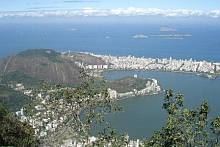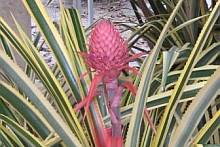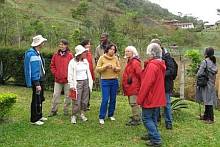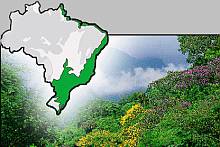Benchmarking observation networks in Brazil
|
I recently had the opportunity to visit Rio de Janeiro to take part in a two-day workshop of the French, Brazilian and South African partners in a project looking at evidence-based policy in agriculture and environmental policies.
The visit was made possible by a Knowledge Interchange and Collaboration travel grant from the National Research Foundation and funds from the ANR (French Research Agency) for the EBPBiosoc project.
The workshop focused on different perspectives on the use of evidence in policy. Dr Jacques Baudry, Françoise Burel and I presented a critique of evidence used in biodiversity conservation policies, either that available evidence is not used or that it is incorrectly applied to different situations.
Marc Kirsch, a philosopher at the College de France suggested we would be better off using the term "evidence-informed policy" rather than evidence-based policy. He pointed out that much of the earlier advances in medicine did not rely on the statistical approaches we regard as paramount to providing rigorous evidence. Both medical and environmental scientists use randomised control trials, the results for the average patient or plot cannot be uncritically applied to the individual.
Several Brazilian presenters highlighted a shortage of graduates trained in environmental issues to provide support for policy development. A new Professional Ecology Masters course is being proposed as a means of overcoming this issue.
Other speakers highlighted how conservation had not always taken people’s reliance on natural resources into account, and many had been expelled from the forests when reserves had been declared.
The South African case study of Working for Water (presented by Dr Frank Matose of the University of the Western Cape and myself) stood out as an example of where decision-makers actively sought scientific knowledge as well as addressing social issues.
Botanical Gardens
The workshop took place at the beautiful old Solar da Imperatriz (Empress’ summer house) which now forms part of the Botanical Gardens.
The Botanical Gardens are 200 years old this year, established by the king of Portugal, Dom João VI, when he visited Brazil to escape Napoleon’s advancing army in Europe. The gardens are in the grand colonial style, with trees and other plants from around the world, originally brought to test their suitability for the local environment. Avenues of sky-high palm trees and an amazing diversity of bromeliads were my favourites.
The Botanical Gardens has its own research facilities, and houses both researchers and postgraduate students, and collections that include bromeliads, orchids, carnivorous plants, and cacti. Director of Research Fabio Scarano described the three monitoring programmes that they are involved in: the PPBio, a network of long-term biodiversity monitoring sites established in 2004 under the Ministry of Science, monitoring of threatened plant species, and the older LTER programme whose future funding is less assured.
I later met Dr Carlos Joly, Professor of Biology at Brazil's UNICAMP and Co-chair UNEP FI Asset Management Working Group at the BIOTA conference in South Africa. He described the observation network that has been set up in São Paulo state in response to the rapid disappearance of local vegetation as production of sugar cane for ethanol took off. The integrating activity has been to map the state of the surviving vegetation, with individual research groups carrying out monitoring at different sites.
A network of flux towers compares carbon and moisture at sites under natural vegetation, sugar cane and eucalyptus. Brazil obviously offers an opportunity to examine and compare the different types of long-term observation networks and the funding structures and institutional frameworks.
Rio de Janeiro is very scenically set among granite plutons whose slopes are covered in Atlantic Forest. This magnificent setting belies some of the challenges facing the natural environment. Rio is a city of some 12 million people and sprawls over a large area. Informal housing creeps up the forested slopes and the waters of the large bay are considered unsuitable for swimming. (Don’t let this put you off from visiting Rio! The famous beaches of Copacabana and Ipanema face the cleaner waters of the Atlantic ocean).
Atlantic Forest
A visit to the Tres Picos State Park and the Macaé de Cima Environmental Protection Area took us across the lowlands – which have been unremittingly transformed - before we climbed the mountains bearing the Atlantic Forest under protection of the State Park.
The Atlantic Forest is home to 20 000 plant species, of which 40% are endemic. Only 8% of the Atlantic Forest survives today and just over half of this is under some form of protection. Several endemic birds, mammals and amphibians are threatened with extinction.
The Atlantic Forest is the lesser known cousin of the Amazon Forest, but because of its prevalence in areas where people have settled and developed for agriculture, in the populous states of São Paulo and Rio de Janiero, it is much more fragmented.
The Tres Picos State Park has been declared to protect the forest and to ensure protection of one of the major catchments supplying Rio de Janeiro city with its water. In this mountainous area, vegetable farming is one of the main activities, with impressively steep slopes cultivated on a rotational system with long fallow periods.
Ironically, legislation to protect the forest, by forbidding farmers to remove trees taller than 2 m forces farmers to cultivate their land on a shorter rotation than previously, or put it under eucalypts!
Tourism is fast taking over as the main money earner in these areas and so quite soon a different set of challenges will be faced by Rio’s natural resources.














